Misty Johnson has taken multiple sclerosis’ best shot.
She’s endured the constant pain in her legs and numbness in her feet that made it so she once didn’t notice when she walked out of her flip-flops. She’s dealt with her vision dimming to the point where she’s legally blind. And she’s experienced the mental anguish that comes with being limited at an age when most are entering their physical prime.
But Johnson hasn’t let the symptoms of MS hold her back, and the 28-year-old Everett resident is hoping she can serve as an example for others who may be going through similar circumstances.
Johnson, with the help of her guide Amy Lewandowski, recently completed the Ironman 70.3 Washington, a half-Ironman triathlon that took place last month in Maple Valley. Despite her MS, despite having little athletic background, and despite being brand new to the sport, Johnson was able to traverse the 70.3 miles of swimming, biking and running, all while tethered to Lewandowski who served as her eyes.
”Anything is possible if you put your mind to it,” Johnson said. “It’s the power of belief. If you believe you can do something, you can. That’s the first step, believing it’s possible.”
♦ ♦ ♦ ♦
In 2016 Johnson’s life was turned upside down.
That’s when Johnson, an Oklahoma native who moved to Everett four years ago, was diagnosed with MS, a debilitating disease that affects the nervous system.
“They called me the textbook case,” Johnson said. “I had every symptom you could think of with MS, from gastro-intestinal to numbness in my feet and legs, and I was almost completely blind.”
But Johnson decided to fight back. In the summer of 2020 she began training for a 5-kilometer run — “When I first got onto a treadmill I couldn’t even run, I had to hold on the whole time because my legs were so numb,” Johnson said — and on July 4, 2021, she completed the Yankee Doodle Dash in Everett while running solo.
But what was the next step? A trip down the YouTube rabbit hole helped inform her decision as a documentary about an Ironman triathlete planted the seed.
“When I saw that video I was so excited internally,” Johnson said. “I had no idea if it was even possible for me to try and do something like that. But I knew if I met the right people and got in the right environment I would be able to do it.”
Johnson found the right environment at the Everett Family YMCA. First, there was a chance encounter on the street with staff member Ryan French, who does triathlons. Then Johnson tracked down the organization’s senior director of health and wellness, Gael Gebow, who also does triathlons. Johnson asked Gebow about doing a sprint-length triathlon. Gebow suggested going bigger.
“She had already told me a little bit about her history and this big dream, and I wanted it to be a better dream than something that lasts maybe an hour-and-a-half,” Gebow said. “The amount of training you put in is part of that dream, and that process and evolution to get to that finish line is immense when it’s something a little bit bigger. I didn’t know she would pick something super big, I was kind of thinking maybe an Olympic distance.”
But unlike a 5K, a triathlon requires a greater perception of one’s surroundings. So Johnson was going to need a guide.
♦ ♦ ♦ ♦
Lewandowski thought she was just cleaning up her equipment at the end of cycle class at the Everett Family YMCA. Instead it was the start of her role in a grand adventure.
Lewandowski, a 41-year-old Lake Stevens resident, happened to be in the room when Johnson and Gebow had their initial conversation. When the subject of a guide came up, Gebow pointed at Lewandowski, who had done triathlons in the past, including one half-Ironman. After some discussion, Lewandowski agreed to serve as guide during the swim portion, while French handled the bike and Gebow did the run. But Ironman later informed Johnson that she was required to have the same guide the entire race.
“When Misty got the email we were walking out of cycle class together. She read that Ironman said she could only have one guide, then she leaned in and elbowed me,” Lewandowski remembered with a laugh. “I’m like, ‘Where’s everyone else?’
“I wasn’t in a space to do a half-Ironman and it was only five months away,” Lewandowski continued. “I knew it took a lot of discipline, a lot of time, a lot of money, a lot of all the things about why I didn’t want to do another half-Ironman. But I went home and talked to my family, my husband was on board, and we had the support of all our friends at the YMCA who have lots of experience with triathlons.”
Lewandowski was in. That began a crash course in training. Johnson found a training regimen online and tailored it to her own needs. The two met up every Wednesday to practice swimming and running together while attached at the hip by an 18-inch bungie tether, as well as practice on a tandem bicycle.
“It was really tricky figuring out how to swim together, how to ride the bike and get clipped in and all the idiosyncrasies of that,” Lewandowski said. “Misty had to put a lot of trust in me. We had a lot of verbal communication, and we had to figure out how to keep that verbal communication real simple so that I’d be able to say something quick and direct to get her to do something.”
Johnson and Lewandowski decided to do the Olympic-length Lake Stevens Triathlon the weekend before the Ironman 70.3 Washington as practice. They navigated the 33.2-mile event without incident, and therefore were ready to tackle the half-Ironman.
♦ ♦ ♦ ♦
Bottle after bottle of water came crashing down on Johnson’s head.
She and Lewandowski were about a mile away from the finish line of the Ironman 70.3 Washington, but Johnson had been suffering from stomach cramps the previous three hours. In addition, Johnson’s MS symptoms increase when her body temperature rises, so Lewandowski was dousing Johnson in water to help lower that temperature.
“We wanted to run across the finish line, but we didn’t want to start too soon becaus we weren’t sure how far she’d make it,” Lewandowski said.
Johnson and Lewandowski got through the 1.2-mile swim, though the water got Johnson’s hands so cold that she needed Lewandowski to help her get her compression socks on. They survived the 56-mile bike ride, though the exertion caused Johnson’s vision to worsen to the point where she never saw the flashing lights of the ambulance that came to attend to another competitor’s crash.
Johnson’s stomach began cramping toward the end of the bike ride, so the duo spent much of the run portion walking. Johnson couldn’t eat or drink, so she resorted to licking ice chips and potato chips.
But Johnson overcame it all as she and Lewandowski crossed the finish line in 7 hours, 20 minutes and 39 seconds. A crowd of about 35 supporters was there to greet them.
“We made it and I just remember going through the finish line,” Johnson said. “I told myself I wasn’t going to get emotional until I made it through the finish line because I know how much it drains me. But it was so hard because there were so many people that were there and I had no idea so many were going to show up and support me.”
♦ ♦ ♦ ♦
Johnson’s success wasn’t just in the moment of crossing the finish line.
The process of training for the triathlon has helped ease Johnson’s MS symptoms, so much so that she’s now able to regulate them without the need of medication. She’s gained a community among her fellow triathletes.
“I’m inspired every day,” Johnson’s husband Seth said. “I always ask myself, ‘What’s my excuse?’ if I ever start being lazy.”
And Johnson’s story isn’t over. Having conquered the half-Ironman, her next target is a full 140.6-mile Ironman. She’s already secured Claire Gilfillan to serve as her guide for a yet-to-be-determined race in 2023.
Johnson was the only para competitor in both the Lake Stevens Triathlon and the Ironman 70.3 Washington. She’s hoping her story can serve as an example to others so that at future triathlons she’s joined other para athletes.
“I want other people with MS or other chronic disabilities to know that they can do this,” Johnson said. “Seeing there were no other para athletes is just another reason for me to keep doing this. It’s a sign. Obviously a lot of people are afraid, and it’s OK to be afraid. But don’t stop living your life because your’e fearful. It’s best to keep moving forward.
“It gets better.”
And Johnson is the living proof.
Talk to us
> Give us your news tips.
> Send us a letter to the editor.
> More Herald contact information.



























